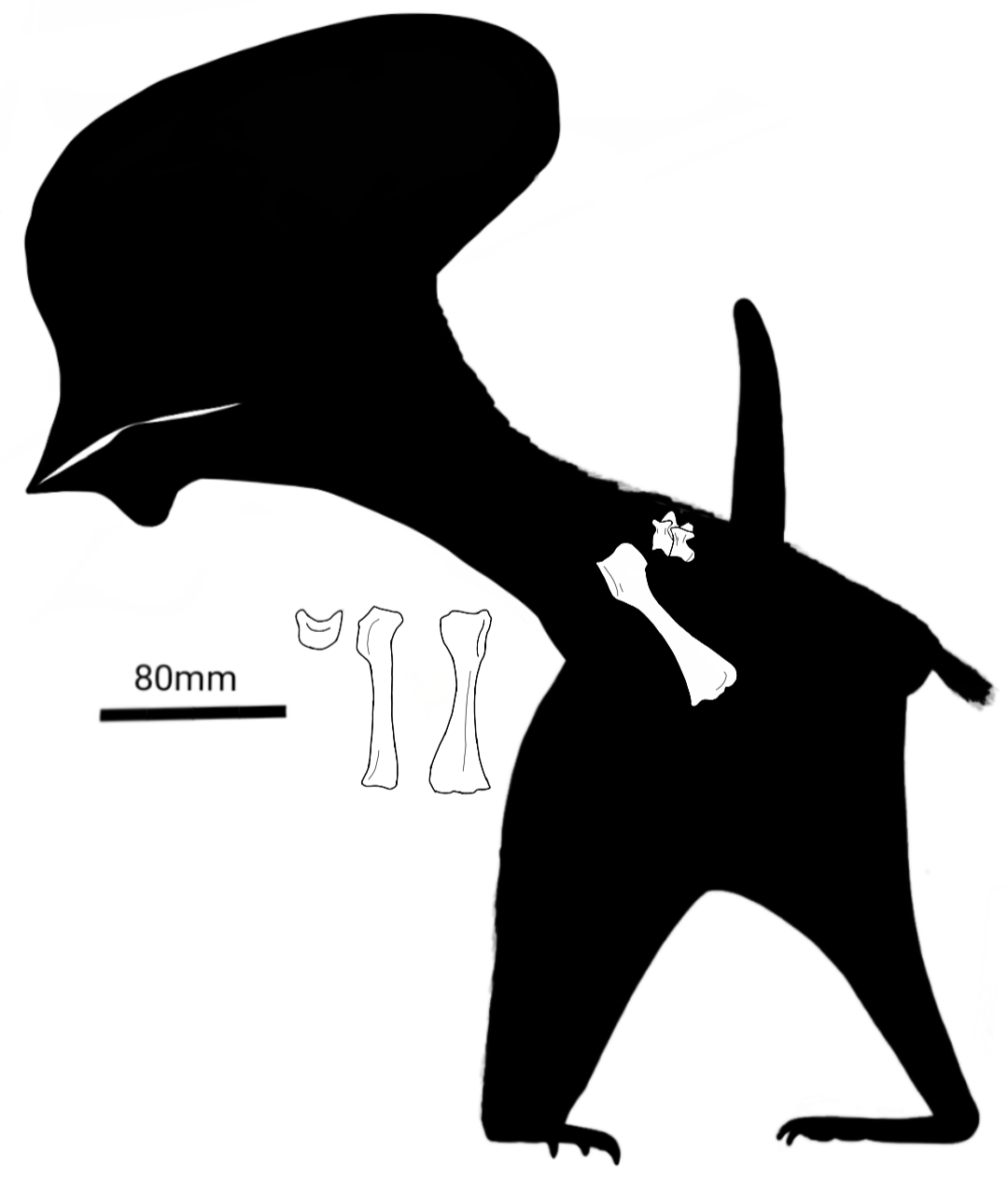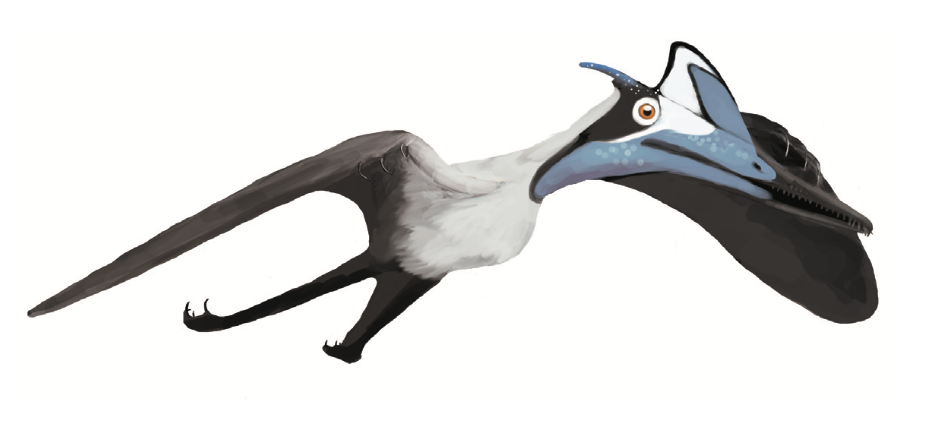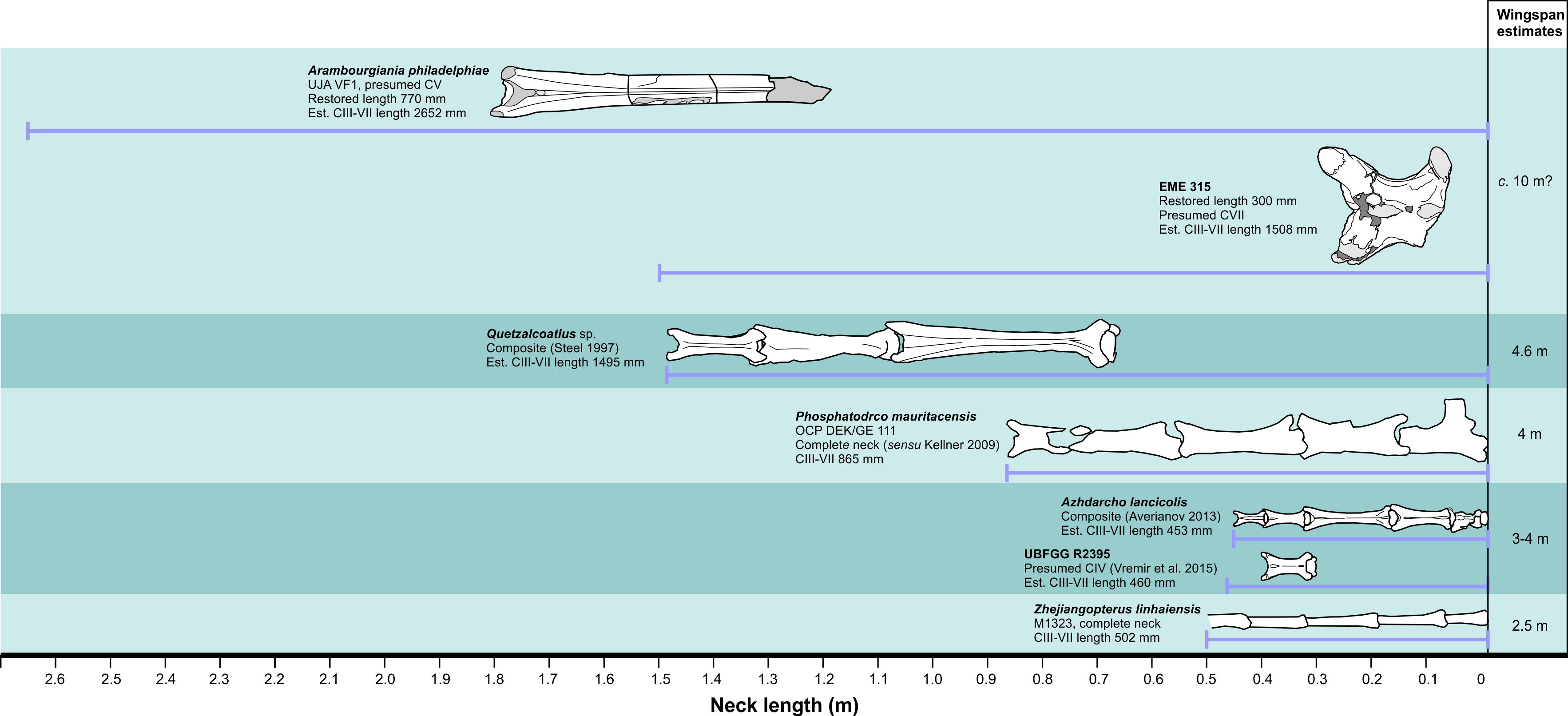|
Bennettazhia
''Bennettazhia'' is a genus of tapejaromorph pterosaur which lived during the Albian stage of the Early Cretaceous from what is now the Hudspeth Formation of the state of Oregon in the United States. Although originally identified as a species of the pteranodontoid pterosaur ''Pteranodon'', ''Bennettazhia'' is now thought to have been a different animal. The type species, type and only species is ''B. oregonensis''. Discovery and history In 1928, Charles W. Gilmore, Charles Gilmore named a new species of ''Pteranodon'': ''P. oregonensis''. A humerus (holotype MPUC V.126713), two fused dorsal vertebrae and the broken-off end of some joint bone had been unearthed from the Lower Cretaceous (Albian stage) beds of the Hudspeth Formation in Wheeler County, Oregon, Wheeler County, Oregon, United States, to which the specific name (zoology), specific epithet refers. Gilmore noted similarities to ''Nyctosaurus'' though the specimens were larger. In 1989, S. Christopher Bennett concluded th ... [...More Info...] [...Related Items...] OR: [Wikipedia] [Google] [Baidu] |
Pteranodon
''Pteranodon'' (; from and ) is a genus of pterosaur that included some of the largest known flying reptiles, with ''P. longiceps'' having a wingspan of over . They lived during the late Cretaceous geological period of North America in present-day Kansas, Nebraska, Wyoming, South Dakota and Alabama. More fossil specimens of ''Pteranodon'' have been found than any other pterosaur, with about 1,200 specimens known to science, many of them well preserved with nearly complete skulls and articulated skeletons. It was an important part of the animal community in the Western Interior Seaway. When the first fossils of ''Pteranodon'' were found, they were assigned to toothed pterosaur genera, ''Ornithocheirus'' and ''Pterodactylus''. In 1876, Othniel Charles Marsh recognised it as a genus of its own, making particular note of its complete lack of teeth, which at the time was unique among pterosaurs. Over the decades, multiple species would be assigned to ''Pteranodon'', though today, o ... [...More Info...] [...Related Items...] OR: [Wikipedia] [Google] [Baidu] |
Hudspeth Formation
The Hudspeth Formation is a Cretaceous sedimentary Geological formation, rock formation, found in Oregon of the United States of America. The formation dates to the Albian age of the Early Cretaceous period. During the Albian much of this formation was submerged beneath shallow seas resulting in the preservation of many marine fossils. Pterosaur, dinosaur and marine fossils have been recovered from the formation. It is intertongued with the Gable Creek Formation. Fossil content Vertebrates Ammonites Other invertebrates See also * List of pterosaur-bearing stratigraphic units * Paleontology in Oregon References Bibliography * * * * {{cite journal , last=Gilmore , first=C.W , year=1928 , title=A new pterosaurian reptile from the marine Cretaceous of Oregon , journal=Proceedings of the United States National Museum , volume=73, issue=2745 , pages=1–5 , doi=10.5479/si.00963801.73-2745.1 Geologic formations of Oregon Cretaceous geol ... [...More Info...] [...Related Items...] OR: [Wikipedia] [Google] [Baidu] |
Tapejaromorph
Azhdarchoidea ( , meaning " azhdarchid-like forms") is a group of pterosaurs within the suborder Pterodactyloidea. Pterosaurs belonging to this group lived throughout the Early and Late Cretaceous periods, with one tentative member, '' Tendaguripterus'', that lived in the Late Jurassic period. Remains of this group have been found in the Americas, Africa, and Eurasia, suggesting that they probably had a global distribution. Azhdarchoids are generally distinguished from other pterodactyloids by their relatively low arm-to-leg-length ratio, suggesting that they were more proficient in moving on the ground than pterosaurs like ''Pteranodon'' or '' Anhanguera'' (which had very long arms relative to the length of their legs). This has led some researchers to suggest that many azhdarchoids, such as the azhdarchids and dsungaripterids, may have been primarily terrestrial, while retaining the ability to fly when necessary. Classification Azhdarchoidea was named by paleontologist Davi ... [...More Info...] [...Related Items...] OR: [Wikipedia] [Google] [Baidu] |
Albian
The Albian is both an age (geology), age of the geologic timescale and a stage (stratigraphy), stage in the stratigraphic column. It is the youngest or uppermost subdivision of the Early Cretaceous, Early/Lower Cretaceous epoch (geology), Epoch/series (stratigraphy), Series. Its approximate time range is 113.0 ± 1.0 annum, Ma to 100.5 ± 0.9 Ma (million years ago). The Albian is preceded by the Aptian and followed by the Cenomanian. Stratigraphic definitions The Albian Stage was first proposed in 1842 by Alcide d'Orbigny. It was named after Alba, the Latin name for Aube (river), River Aube in France. A Global Boundary Stratotype Section and Point (GSSP), ratified by the IUGS in 2016, defines the base of the Albian as the first occurrence of the planktonic foraminiferan ''Hedbergellidae, Microhedbergella renilaevis'' at the Col de Pré-Guittard section, Arnayon, Drôme, France. The top of the Albian Stage (the base of the Cenomanian Stage and Upper Cretaceous Series) is defined ... [...More Info...] [...Related Items...] OR: [Wikipedia] [Google] [Baidu] |
Dsungaripteridae
Dsungaripteridae is a group of pterosaurs within the suborder Pterodactyloidea. They were robust pterosaurs with good terrestrial abilities and flight honed for inland settings, and were commonly interpreted as durophagous and possibly piscivorous pterosaurs. Fossils have been discovered from Early Cretaceous deposits in Asia, South America and possibly Europe. Classification In 1964, Young created a family to place the genus '' Dsungaripterus'', a Chinese taxon with potential remains also known from the Hasandong Formation of South Korea. Later on, '' Noripterus'' (then now with the name " Phobetor" which was already occupied, therefore the quotation marks) was also assigned to the family. In 2003, Alexander Kellner gave the exact definition as a clade:Kellner, A.W.A., 2003. Pterosaur phylogeny and comments on the evolutionary history of the AN group. In: Buffetaut, E., Mazin, J.M. (Eds.), ''Evolution and Palaeobiology of Pterosaurs. Geological Society, London, Special Public ... [...More Info...] [...Related Items...] OR: [Wikipedia] [Google] [Baidu] |
Lev Nesov
Lev or LEV may refer to: People and fictional characters *Lev (given name) *Lev (surname) Places *Lev, Azerbaijan, a village * Lev (crater), a tiny lunar crater Religion *an abbreviation for Leviticus, the third book of the Hebrew Bible and the Torah *Lay eucharistic visitor, an extraordinary minister of Holy Communion approved by a church (usually Episcopalian or Lutheran) to bring Communion to the homebound *Libreria Editrice Vaticana, the Vatican Publishing House Transportation * Leyland Experimental Vehicle, a type of British experimental railbus *Light electric vehicle, an electric bicycle *Low emission vehicle, a motor vehicle that emits relatively low levels of motor vehicle emissions *Lunar Excursion Vehicle, an early name for the Apollo Lunar Module Political and other * Lesser evil voting (LEV) *Lev (political party), a now-defunct political party in Israel *LEV (cable system), a submarine cable system linking countries in the eastern Mediterranean *''Lev!'', a Swedi ... [...More Info...] [...Related Items...] OR: [Wikipedia] [Google] [Baidu] |
Persian Language
Persian ( ), also known by its endonym and exonym, endonym Farsi (, Fārsī ), is a Western Iranian languages, Western Iranian language belonging to the Iranian languages, Iranian branch of the Indo-Iranian languages, Indo-Iranian subdivision of the Indo-European languages. Persian is a pluricentric language predominantly spoken and used officially within Iran, Afghanistan, and Tajikistan in three mutual intelligibility, mutually intelligible standard language, standard varieties, respectively Iranian Persian (officially known as ''Persian''), Dari, Dari Persian (officially known as ''Dari'' since 1964), and Tajik language, Tajiki Persian (officially known as ''Tajik'' since 1999).Siddikzoda, S. "Tajik Language: Farsi or not Farsi?" in ''Media Insight Central Asia #27'', August 2002. It is also spoken natively in the Tajik variety by a significant population within Uzbekistan, as well as within other regions with a Persianate society, Persianate history in the cultural sphere o ... [...More Info...] [...Related Items...] OR: [Wikipedia] [Google] [Baidu] |
Azhdarcho
''Azhdarcho'' is a genus of azhdarchid pterosaur from the late Cretaceous Period (geology), Period of the Bissekty Formation (middle Turonian stage, about 92 million years ago) of Uzbekistan, as well as the Zhirkindek Formation of Kazakhstan and possibly also the Ialovachsk Formation of Tajikistan. It is known from fragmentary remains including the distinctive, elongated neck vertebrae that characterizes members of the family Azhdarchidae, a family that includes many giant pterosaurs such as ''Quetzalcoatlus''. The name ''Azhdarcho'' comes from the Persian language, Persian word ''Azhdaha, azhdar'' (), a dragon-like creature in Persian mythology. The type species is ''Azhdarcho lancicollis''. The specific name (zoology), specific epithet ''lancicollis'' is derived from the Latin words ''lancea'' (meaning "lance" or "spear") and ''collum'' ("neck"). Most individuals were relatively small with an estimated wingspan of , but some remains indicate a larger wingspan of . History Th ... [...More Info...] [...Related Items...] OR: [Wikipedia] [Google] [Baidu] |
Type Genus
In biological taxonomy, the type genus (''genus typica'') is the genus which defines a biological family and the root of the family name. Zoological nomenclature According to the International Code of Zoological Nomenclature, "The name-bearing type of a nominal family-group taxon is a nominal genus called the 'type genus'; the family-group name is based upon that of the type genus." Any family-group name must have a type genus (and any genus-group name must have a type species, but any species-group name may, but need not, have one or more type specimens). The type genus for a family-group name is also the genus that provided the stem to which was added the ending -idae (for families). :Example: The family name Formicidae has as its type genus the genus ''Formica'' Linnaeus, 1758. Botanical nomenclature In botanical nomenclature, the phrase "type genus" is used, unofficially, as a term of convenience. In the '' ICN'' this phrase has no status. The code uses type specimens ... [...More Info...] [...Related Items...] OR: [Wikipedia] [Google] [Baidu] |
Guano
Guano (Spanish from ) is the accumulated excrement of seabirds or bats. Guano is a highly effective fertiliser due to the high content of nitrogen, phosphate, and potassium, all key nutrients essential for plant growth. Guano was also, to a lesser extent, sought for the production of gunpowder and other explosive materials. The 19th-century seabird guano trade played a pivotal role in the development of modern Intensive farming, input-intensive farming. The demand for guano spurred the human colonisation of remote bird islands in many parts of the world. Unsustainable seabird guano mining processes can result in permanent habitat destruction and the loss of millions of seabirds. Bat guano is found in caves throughout the world. Many cave ecosystems are wholly dependent on bats to provide nutrients via their guano which supports bacteria, Fungus, fungi, invertebrates, and vertebrates. The loss of bats from a cave can result in the extinction of species that rely on their guano ... [...More Info...] [...Related Items...] OR: [Wikipedia] [Google] [Baidu] |
Tapejaridae
Tapejaridae (from a Tupi language, Tupi word meaning 'the lord of the ways') is a Family (biology), family of azhdarchoid pterosaurs from the Cretaceous Period (geology), period. Members are currently known from Brazil, England, Hungary, Morocco, Spain, the United States, and China. The most primitive genera were found in China, indicating that the family has an Asian origin. Description Tapejarids were small to medium-sized pterosaurs with several unique, shared characteristics, mainly relating to the skull. Most tapejarids possessed a bony crest arising from the snout (formed mostly by the premaxillary bones of the upper jaw tip). In some species, this bony crest is known to have supported an even larger crest of softer, fibrous tissue that extends back along the skull. Tapejarids are also characterized by their large nasoantorbital fenestra, the main opening in the skull in front of the eyes, which spans at least half the length of the entire skull in this family. Their eye so ... [...More Info...] [...Related Items...] OR: [Wikipedia] [Google] [Baidu] |
Thalassodrominae
Thalassodromidae (meaning "sea runners") is a group of azhdarchoid pterosaurs from the Early Cretaceous (Albian) of Brazil. All known definitive members come from the Romualdo Formation of Brazil, which include the type genus ''Thalassodromeus'', as well as ''Tupuxuara'' and ''Kariridraco''. Proposals of additional thalassodromid genera from the Late Cretaceous are controversial and have not been supported. The classification of Thalassodromidae is quite controversial and disputed. It was initially denominated Thalassodrominae, as a subfamily within the group Tapejaridae. However, opposing studies regarding its placement have argued that its members were more closely related to azhdarchids and dsungaripterids, while also elevating it to family level. Though the relationship with tapejarids remains supported by many studies, it has been proposed that it is preferable to retain them as a distinct family for consistency of communication. Classification The classification of thalass ... [...More Info...] [...Related Items...] OR: [Wikipedia] [Google] [Baidu] |








